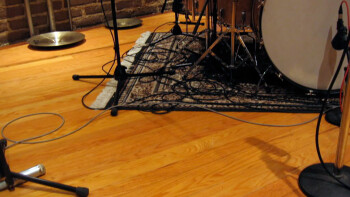Today's article will be the last one dedicated to the Stereo Room recordings. This time we'll discuss more convoluted techniques.

Let’s begin with a method where you use two cardioid mics pointing directly towards the floor of the room, with the capsules only an inch or so away from the floor. This can be particularly interesting when the surface naturally produces a nice reverberation, as is the case with parquet, for instance. That said, you can always just put a plywood board on the floor to emulate the effect. Granted, the result won’t be as good, but you’d be surprised by the results you can get with this little trick!
Regarding the position of the mics with respect to the drums, you can play with the stereo sensation of the kit placing one mic on each side. Also note that the closer to the kick the mics are, the more bass drum you’ll get, obviously, while reducing the reverb of the snare and the cymbals. This might prove very interesting if you are looking for some powerful low mids. But be careful not to overdo it, because you might end up drowning the whole drum kit. Furthermore, keep in mind any potential phase issues that may arise between these mics and the ones you used to close mic the kick, or you could end up losing attack precision and/or body.
If you really like the “power” sensation this technique provides, but your notice that the drums lose too much clarity and/or precision, you can use a slight variant. Instead of having the mics pointing towards the floor, use a pair of cardiod condenser mics, like the Oktava MC012 or AKG C 451, and place them directly on the floor aiming towards the kit. In this setup the capsule is very close to the reverberating surface while facing directly the sound source. So what, you ask? Well, the time difference between the direct sound and the reverberated sound is reduced, which means there will be less comb filtering and the result will be more “pure” but just as “powerful.”
The only thing is that this method requires everybody present in the room to be extremely mindful of the mics placed on the floor! In fact, as bizarre as it may seem, the more expensive the mic, the less it will tolerate being stepped on.
Stepping through the door
The last method to record Stereo Room tracks we’ll discuss consists in placing the mics outside the room where the drum kit is, in the room next door or the hall, for instance. This technique is obviously not the most faithful when it comes to portraying the stereo image, but it can nevertheless add some breadth to the overall result. On the other hand, you’ll only capture the reverb, no direct sound. These tracks can take particularly well heavy compression during mixdown – think Led Zeppelin! Besides, you can control the spectral balance of the tracks playing with the opening of the doors of the rooms: the more open, the more highs you’ll get. Do note that this technique works best on slow or rhythmically simple songs. A fast or busy groove will probably end up being drowned up by the reverberation recorded this way.
And that’s it for today. See you next time for some new adventures in recording!

